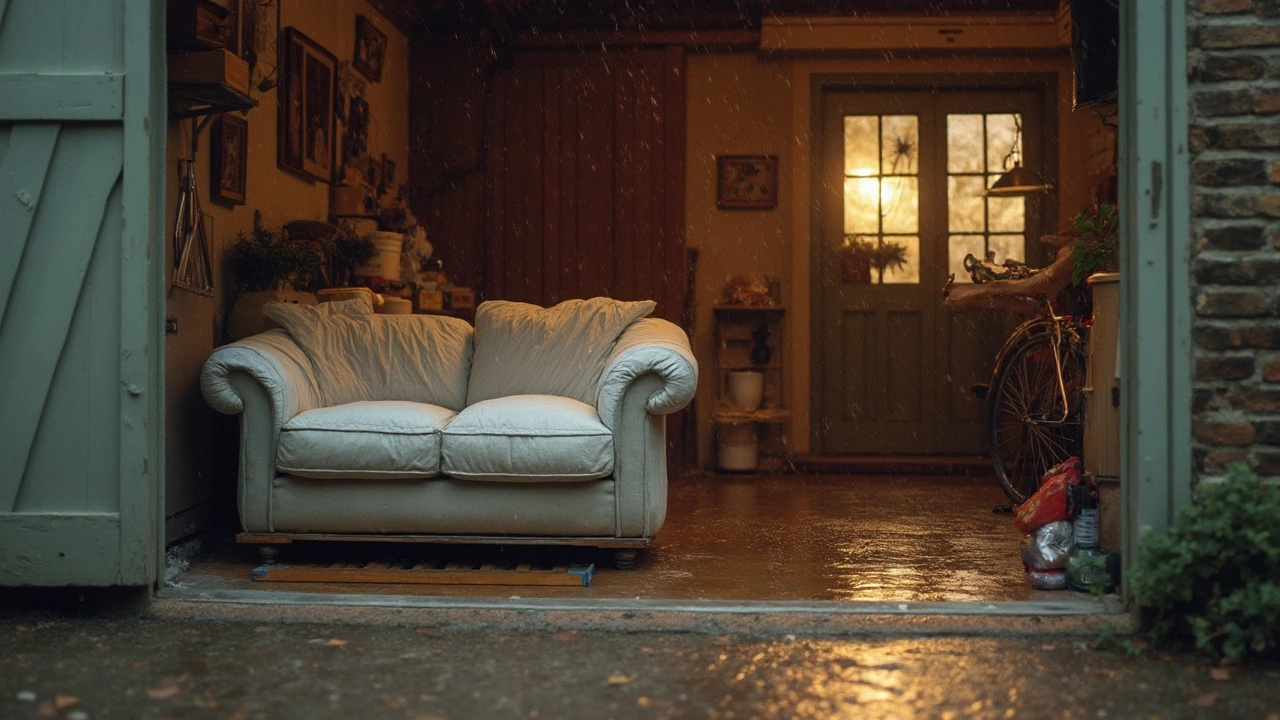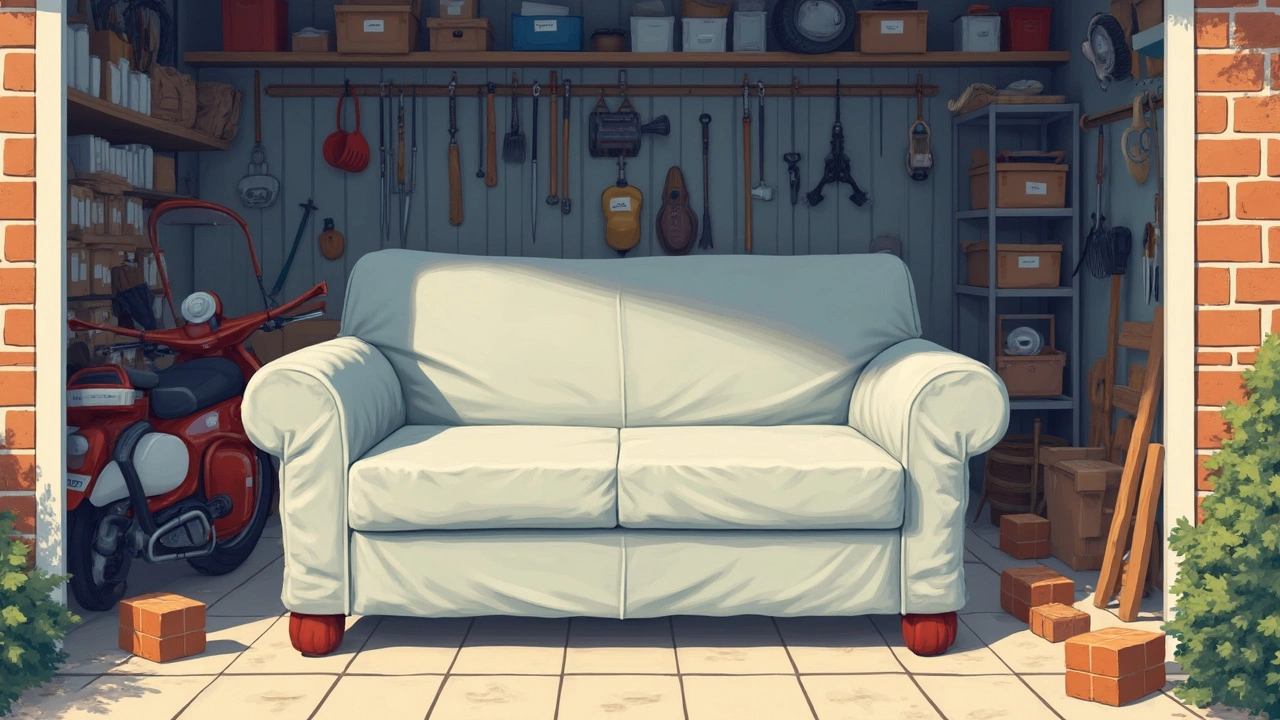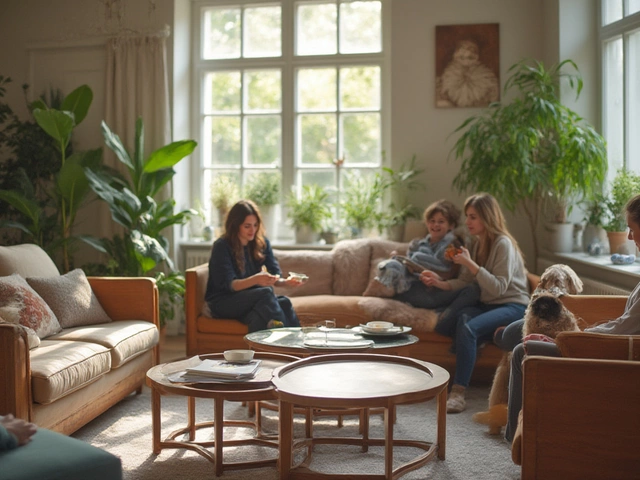 13
Feb,2025
13
Feb,2025
So, you're thinking about tucking your couch away in the garage? It's a pretty common idea, especially if you're short on space inside your home. But is it the best move? Here's the deal: garages offer a quick solution, but they come with their own set of challenges. Picture it – your trusty couch settling in next to dusty boxes and that leaky oil can. Not the ideal spot, right?
If you're leaning toward this option, there's more to think about than just space. Garages aren't known for their warmth or dryness. In fact, they can feel like a mini ecosystem where humidity, temperature swings, and even critters could sneak up on your unsuspecting sofa. But don't worry, with a few smart choices and a little effort, you can keep that couch pretty safe.
Start by giving it a good clean. Nothing worse than stashing dust and crumbs that might attract uninvited guests later. Once that's done, cover it up with a breathable fabric, like a drop cloth. Avoid plastic; it traps moisture and can lead to mold. And if you can, lift it off the ground with a couple of pallets to help airflow and keep it dry. There's a lot more to keeping your couch comfy in a garage, and I’ll walk you through everything you need to know.
- Why Store a Couch in the Garage?
- Potential Risks Involved
- Tips for Safe Storage
- Protecting Against Moisture
- Pest Prevention Strategies
- When to Consider Alternative Storage
Why Store a Couch in the Garage?
Alright, so you might be wondering why anyone would consider putting their couch in a garage in the first place. Well, there are a couple of good reasons you might not have thought of. First off, if you're short on space inside the house or doing some redecorating, that trusty old couch needs a temporary home. Garages are big and empty, making them an attractive option.
Then there's the cost factor. Renting a storage unit isn't always cheap. So, if you're looking to save some cash, a few months in the garage might be a reasonable trade-off. Of course, it’s not perfect, but garages are often right there on your property, making them super convenient. You don’t have to drive to some far-off storage facility every time you need to grab something off the couch.
Temporary Storage Solution
Sometimes life throws a curveball, like surprise renovations or an unexpected move. In those cases, using the garage for furniture storage can be a temporary fix. It's great for short-term transitions, things that only last a few weeks or months.
Downsizing but Not Yet Selling
Maybe you're downsizing to a smaller place and aren't ready to sell your furniture. Storing it in the garage gives you more time to decide without the immediate pressure. This way, if plans change or you need that couch back, you haven’t made any drastic decisions you’ll regret.
Having a couch in the garage isn't just about saving space or money. It's also about flexibility and having options when life gets a bit too hectic. But don’t forget, there’s a balance to strike in making sure that garage furniture storage works out—and that means taking some steps to protect your couch.
Potential Risks Involved
Storing your couch in the garage might seem like a simple way to free up some room, but it comes with a few risks that you should know about. Leaving furniture in a garage isn't just about slipping it into an empty spot and calling it a day. There's a lot that can go wrong if you're not careful.
Moisture Issues
Garages are notorious for moisture problems. Most garages aren't sealed like the rest of your home, which means they can get pretty damp, especially in rainy climates or winter months. Moisture can warp frames, cause fabric to mold, and even rust any metal parts on your couch. Not fun! To combat this, keeping your couch covered with a fabric sheet and elevated off the ground can help keep it dry.
Temperature Fluctuations
Another problem worth mentioning is temperature swings. Garages are often uninsulated, which means temperatures can soar in the summer and plummet in the winter. These ups and downs can damage the upholstery over time, causing it to fade or crack. If the garage has good ventilation or the ability to regulate temperature, that’s a huge plus.
Pest Invasions
Last but not least, let's chat about the creepy crawlies. Critters like rodents and insects love garages. They see a garage-stored furniture item as both a new home and a tasty snack. Yikes! It’s essential to check for any gaps or holes they might sneak through and use pest repellents if necessary.
| Risk | Effects |
|---|---|
| Moisture | Warping, mold, rust |
| Temperature Changes | Upholstery damage |
| Pests | Fabric damage, potential infestations |
Some might weigh these risks and still feel confident about storing their couch in the garage, especially with preventative measures in place. But if you're risk-averse or love your couch a whole lot, you might want to reassess.
Tips for Safe Storage
So you're planning to stash your couch in the garage. Let's make sure it emerges just as comfy and inviting as the day you left it there. Here are some practical steps to make that happen.
1. Clean Before You Store
First off, give your couch a thorough clean. Remove cushions, vacuum corners, and maybe even wash any removable covers if your couch has them. Just think about it—dust and crumbs can attract pests, turning your cozy couch into a pest playground. No one wants that!
2. Choose the Right Spot
Placement matters. Keep your couch away from any garage doors, windows, or walls where moisture might sneak in. If there's a possibility, place it near an interior wall to avoid drastic temperature changes.
3. Elevate the Couch
If it's sitting directly on the concrete, that's a no-go. Use pallets or even cinder blocks to lift it just a bit off the floor. This helps air circulation and guards against moisture seeping up from the ground.
4. Protect with Covers
Cover your couch with a breathable material, like a cotton drop cloth or a moving blanket. Avoid plastic—it's tempting, but it traps moisture, leading to mildew and mold.
5. Control the Environment
If you can, try using a dehumidifier or moisture absorbers in your garage to keep humidity in check. Another tip is to place it in a spot away from direct sunlight that can fade the fabric over time.
6. Check on It Regularly
A quick look every couple of months can save a lot of headaches. Check for signs of moisture, pests, or any odd smells. Early detection can stop an issue before it turns big.
By following these steps, you give your couch the best chance to survive its garage vacation unscathed. It might take a bit of effort, but it'll be well worth it when you're cozied up again on a spotless sofa!

Protecting Against Moisture
Moisture is pretty much the enemy of any couch storage situation, especially in a garage. These spaces aren't exactly designed with furniture in mind, making moisture control a top priority. Let's get into a few strategies to help keep your couch dry and free from any musty surprises.
1. Use a Dehumidifier
If your garage tends to get damp, then a dehumidifier is your new best friend. These devices help suck the excess moisture right out of the air, which is crucial for preventing mold and mildew. Check out models rated for larger spaces to get the job done effectively.
2. Choose the Right Cover
When you're storing a couch, the cover you choose can make a huge difference. Go with a breathable cover like a cotton drop cloth. This helps keep dust off while letting air circulate, reducing the chance of moisture build-up. Steering clear of plastic is smart because plastic can trap moisture and lead to all sorts of fungi nightmares.
3. Elevate the Couch
Lifting your couch off the concrete floor is more effective than you might think. Placing wooden pallets or blocks under the legs of your furniture can prevent direct contact with humid surfaces. This small step can significantly reduce moisture absorption and increase airflow.
4. Proper Air Circulation
Good ventilation helps keep moisture at bay. If your garage has windows, consider cracking them open from time to time for fresh air. Fans can also help circulate air throughout the space, keeping everything drier.
| Average Relative Humidity | Mold Growth Rate |
|---|---|
| Below 50% | Very Low |
| 50-70% | Medium |
| Above 70% | High |
Following these steps can vastly reduce the chance of moisture messing with your stored furniture. So, if you're serious about keeping your couch in good shape, tackling humidity is a must. Trust me, your furniture will thank you!
Pest Prevention Strategies
When you're storing a couch in the garage, pests can become your worst nightmare. Imagine mice snuggling into your cushions or bugs crawling under the fabric – not a pretty thought, right? Luckily, keeping those critters out is totally doable with the right tactics.
Seal Off Entries
First off, check your garage for any sneaky entry points. Pests love gaps and cracks, especially around doors and windows. A bit of weather stripping or caulking can go a long way in blocking tiny invaders.
Use Strong Scents
Another nifty trick is to use scents that pests hate. Peppermint oil is a natural deterrent for rodents. A few soaked cotton balls placed around your furniture storage area can do wonders. Plus, your garage will smell fresh!
Elevate and Cover
As already mentioned, elevating your couch can be a game-changer. Using pallets or blocks not only keeps moisture away but also deters pests who tend to stick close to the ground. Make sure to cover your couch with something breathable to protect against both moisture and critters.
Set Traps and Deterrents
If you're in a garage that's already seen its fair share of critters, setting traps might be a wise move. Snap traps, glue boards, or even ultrasonic pest repellents can keep your garage furniture safe. Just make sure they're placed away from the couch itself to avoid any accidents.
Keep the Area Clean
Lastly, maintain a tidy garage. Clutter provides a hiding place for pests, making them feel right at home. Regularly sweep the floor, get rid of any food or trash, and periodically check around your couch storage for any signs of encroachment.
By giving these strategies a try, you'll make your garage an uninviting place for pests while keeping your couch safe. It's all about taking a few extra steps to ensure your furniture care is top-notch while stored outside your regular living space.
When to Consider Alternative Storage
While using the garage to store a couch may sound handy, it’s not always the best approach. You might need to think about alternative storage options if your garage has certain quirks. So, when should you look at other storage methods?
Signs Your Garage Isn't Suitable
If your garage floods during heavy rain, no cover will completely protect your furniture. Also, if temperatures drop below freezing or shoot up in the summer, your couch could warp or discolor. Constant moisture problems or pest issues are big red flags too. Watch out for signs like rust on tools or rodent droppings.
Better Alternatives to Garage Storage
Consider using a climate-controlled storage unit if you spot any of these signs. They're specifically designed to keep furniture comfy all year round. Another option? Check if a friend or family member has some extra space. Just make sure their conditions meet the right environment for your couch.
Weighing the Costs
Alternative storage options might involve extra costs, but think about it: your couch probably wasn't cheap. Spending a bit now on proper storage can save money on future repairs or replacement.
| Option | Potential Cost | Protection Level |
|---|---|---|
| Climate-Controlled Unit | $75-$150/month | High |
| Friend's Basement | -$0 | Medium |
| Unattended Garage | $0 | Low |
Get the Timing Right
If you expect to get the couch out often or soon, say within the next few months, it might not be worth the hassle of moving it multiple times. On the flip side, if it's for long-term storage, you want it in a safe spot regardless of the hassle.
Thinking it through can help make sure the couch you love stays just as cozy wherever it gets stashed!




